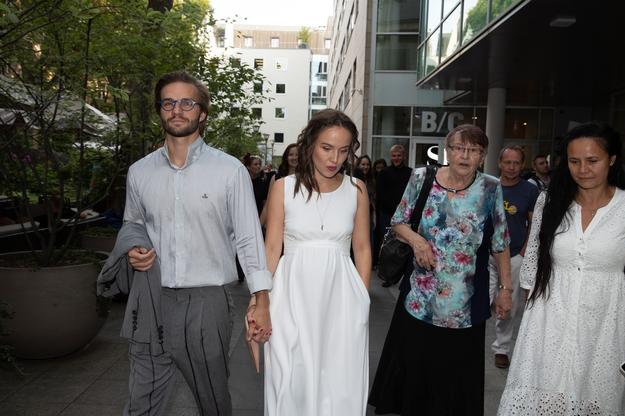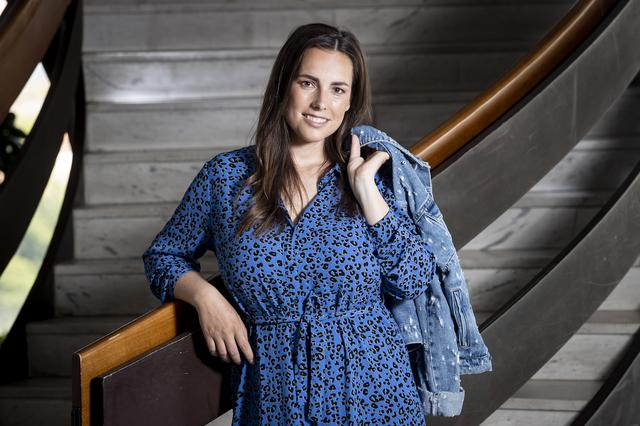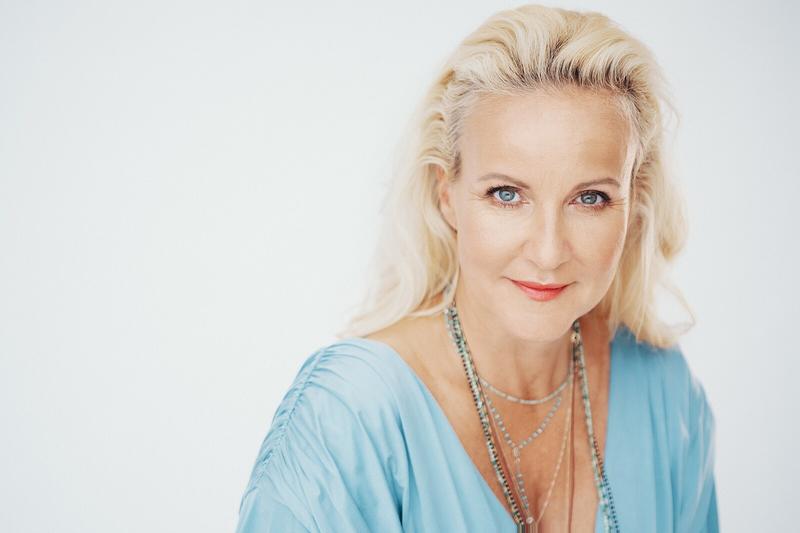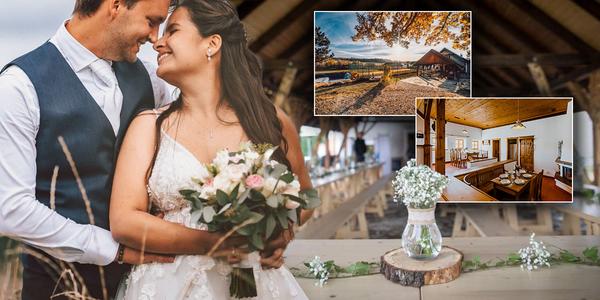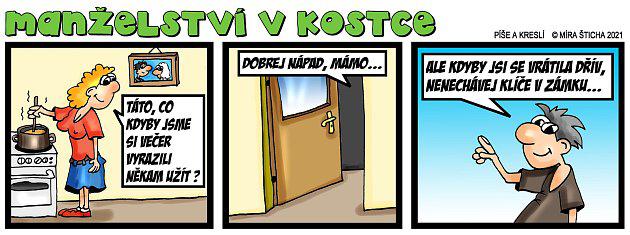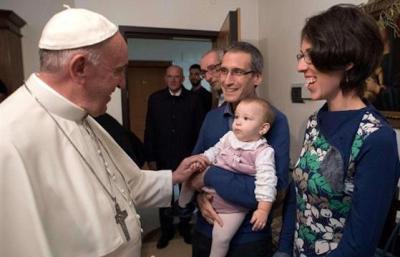My partner Vlastimil Šenkýř taught me to love my body, says fashion designer Kristýna Lovas Šenkýřová, who also focuses on +size fashion in her work - CZECHDESIGN<
How did you get into art and specifically fashion?
KRISTÝNA: I've always enjoyed dressing up and I've noticed the differences in cuts since I was little. I often found unusual pieces in thrift stores or bought things from my grandmother that are actually coming into fashion now. They didn't really understand it at the base, but I was fascinated by some of the clothes and enjoyed wearing them. Then I found meaning in the fact that I can actually create the pieces. And that was perhaps the reason why I discovered that this field suits me.
So you knew from childhood that you wanted to study fashion or at least devote yourself to it?
KRISTYNA: Not really. I wanted to be a hairdresser since I was little, for example I never sewed or made clothes for dolls and my mother told me about the art dress school sometime during the 6th grade in primary school. Thanks to this, I started to prepare for entrance exams, got into secondary school and then studied a bachelor's degree at FDULS in Pilsen and now another bachelor's degree at UMPRUM, which I will not finish, because I was accepted for a master's degree in the same studio. Studying is quite financially demanding, so we agreed at home that it would be best to move on.
For the RA.OD.VE collection. Kristýna received the studio award at FDULS in Pilsen. | Photo: Natalie Kuznetsová
Do you feel any differences between the schools? How did studying each one affect you?
KRISTÝNA: Both schools have something in common. I love Pilsen for its atmosphere and open space, but at the same time I perceive that they don't have very good PR in Pilsen, and even if the student is the best, he doesn't know how to promote himself, so the public usually doesn't know about him. At the same time, I relaxed there, I understood that fashion is not only about basic cutting structures, and I also searched a lot there. I understood roughly where I would like to go in fashion - I am interested in women's clothing, the female body and how clothes make them feel and what is good for them, I like homely lavish clothes and other sometimes even banal fragments of clothing that I like to work with and I continue to develop them. In Prague, I learned to relax a lot, pay attention to processing and also know how to present my work, for which I have to thank Professor Liběná Rochová all the time.
So you've been involved in fashion since high school. Is there anything that convinced you that you were headed in the right direction?
KRISTÝNA: The first moment when I realized that I was headed in the right direction was when I received an atelier award in Pilsen for my RA.OD.VE collection. The second time I realized this was when I got on the stage and made the initial mini White Project collection and then I saw its photographic output. I usually realize that I am doing meaningful things only when I see the finished photoshoot. It is also thanks to the people I have around me and who help me with the climb. I am very happy that I have created such a great "team" during that time.
Kristýna's first collection at UMPRUM was White Project. | Photo: Natalie Kuznetsová
White Project | Photo: Natalie Kuznetsová
Do you have a favorite among your projects that you like to return to?
KRISTÝNA: Unfortunately, not much was heard about the work we did with the knitting company Novia Fashion from Krásná Lípa, when we had the wonderful opportunity to have our own pattern knitted. The project was supposed to be exhibited in Milan, but it was canceled due to covid. We collaborated with a graphic design studio and the topic was Message, when we had to come up with our own message, the message we want to send on. My message with Kryštof Novák, a student at the Studio of Graphic Design and Visual Communication, was about self-presentation on social networks. I was fascinated by the fact that people present themselves only from the front, most often focusing on the face, and are no longer interested in what is behind or below it. As a pattern, we used a raster that was created by accident when I uploaded a photo to Instagram and it got pixelated. Thanks to this, a knitting pattern was created, which we had thanks to the amazing talent of Kryštof Novák and the company in Krásná Lípa knit. I really enjoyed this project. Again, I have to point out that without such skilled and willing people, what was created would not have been created, including the photographic output of this Fake Perfection project by Luria Ladutko.
The Fake Perfection collection responds to the topic of self-presentation on social networks. | Photo: Luria Ladutko
The Fake Perfection collection was created in collaboration with graphic designer Kryštof Novák. | Photo: Luria Ladutko
Since you mentioned covid and what changed or didn't happen because of it, how did you spend the last year? Has covid affected your work?
KRISTÝNA: Last winter semester was quite demanding for me, I didn't feel very well mentally and at the same time I found out that I can't create and design. Liběna Rochová and I always used to have long consultations, and Liběna used to tell me: "Kristýna, I know it's in you, but it's still not the same." In the end, I only had a week until the end of the submission and I had to literally give up my coat for the Ony project squeeze out. This work made me realize that I can't stay with the sketches for long, but I have to make the calico as quickly as possible and work briskly. It was such a harrowing semester, but I was glad for it, because we had the topic "Own online presentation", where we created both the product and the design of the e-shop and, best of all, the website, which is the only option in today's online world presentation. It forced us all to try it, maybe it gave me a kick, and thanks to that, I'm still working on my website together with Natalia Kuznetsova.
As a clothing designer, how do you perceive fashion? What do you like to wear and what do you not?
KRISTÝNA: I like it when fashion is useful and wearable and at the same time elegant with a touch of feminism. I don't know how to describe it, but I like it when a woman is dressed well, but not flamboyantly. I don't like it when people put well-known brands in the middle of their T-shirt, on their shoes, on the side of their pants, in short everywhere, because I don't find the quality in that.
A coat from the Ony | project Photo: Natalie Kuznetsová
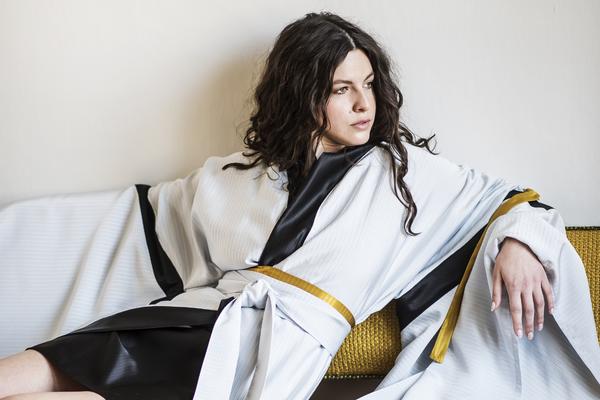
And me and fashion? I try to avoid fast fashion brands. One way is to support my favorite designers, whether in clothing or accessories. Another way is to look for great pieces in vintage shops and second hand stores.
So you try to live and create in the idea of slow fashion. Would you like to change something in fashion with your work or give it something new?
KRISTÝNA: My goal is to have limited series where the customer will be sure that the piece will last for him, and if it happens to be damaged, he will bring it and have it repaired. For me, sustainability is also about educating people, as Bára Procházková does for example with Project Sapience. It's hard to invest in quality pieces these days because we have enough of everything and can afford to buy new things. I think that if we started investing more in clothes, we would take better care of them and appreciate them more.
You mentioned that educating citizens in relation to sustainability is also important. Do you feel that people in our country have a different attitude towards fashion and maybe fast fashion in particular than it did years ago?
KRISTÍNA: I think things have improved recently. A few years ago, these issues were not so well known in the wider public, but I think the younger generation is also more interested in it. But again, I think that the financial aspect plays a big role here, when people prefer to reach for fast fashion rather than buy a more expensive piece for pleasure once in a while. Sometimes I hear from people that even the t-shirts at H&M only last a few months instead of years, and I think that also makes people perceive that the clothes are not as good as they should be.
What led you to start your own Lovas brand?
KRISTYNA: I feel that I am unemployable (laughs). No, it's more my dream to be my own boss, to have everything under my direction and to be self-sufficient. I don't need to be a big brand, but I'd love to be a little Lovas, doing miniseries as long as it makes sense to me. I'm still at the beginning, it's still not the same. My Skin Top, for example, was created so that I could try it at all. My husband Vlastimil Šenkýř helped me a lot to establish the brand itself. I have a tendency to delay everything and Vlastimil told me to do it right away. It took me a long time to find the right materials and skilled seamstresses who complete my tops, as well as to think through the right pricing so that I have something left over. I'm still learning because numbers are a big problem for me, but I'm taking it as a great experience.
My Skin Top is the initial project of the Lovas brand. | Photo: Viktorie Macánová
Kristýna designed the My Skin Bag from the remnants of the fabrics used to make the My Skin Top. | Photo: Viktorie Macánová
When you mentioned pricing, were you taught it during your studies at university? Did they show you how to start your brand and what it takes to do it?
KRISTÝNA: Unfortunately, I missed it in Pilsen. We knew how to create a product and how to photograph it, but maybe we didn't know how to start a business and what it all entails. We were missing such important details that one encounters in life. In Prague, they started holding business skills lectures with guests from various industries, which helped me a lot. I think that today this should be taught in secondary schools as well.
Why did you decide to create My Skin Top and then My Skin Bag as your first product?
KRISTÝNA: My Skin Top was created thanks to the White Project, when it was one of the options I wanted to go for, but Liběna said that it wasn't it and that many people already do the stretching and pulling of the fabric. Which of course is true, but somehow I felt that I wanted to do it. I chose the top because of that, because it seems to me that a person buys a top and can wear it at any time. The pouch came about over time because it became apparent that as I create the My Skin Top, I leave behind a lot of unused fabric scraps. It seems to me that the processing of leftovers is becoming automatic these days even with a lot of other big brands that take it for granted and not as something on which the brand would build its image, which I see as a big plus.
What materials do you use in your work? Do you have any favorites or are you more of an experimenter?
KRISTÝNA: I think I could experiment more materially, but I also enjoy a certain tactility and adding volume or contraction. For example, when I just gather the fabric, it is different than when I dissolve it, I really enjoy that it can be both flat and voluminous. I also like layering and the ability to wash fabrics. Because of this, I have an idea in my head to create more tactile tops that encourage touch, but that's just the beginning. In time, I would like to work with natural materials, because My Skin Top is, for example, entirely made of polyester. If it were to be made of natural material, first of all, it would not be as resilient and, secondly, its price would be several times higher, which of course would be possible, but on the basis of an individual order by the customer. In time, I would like to work completely on natural materials only. I'm betting a lot on Balance is Motion (BIM), a new company that deals with the circular economy and sustainability, and is available to large companies and independent designers.
My Skin Top is now available in three color variants. | Photo: Viktorie Macánová
You produce tops and bags in small series. Do you have any feedback on them and the entire Lovas brand?
KRISTÝNA: Yes, mainly thanks to social networks and also thanks to the sale of My Skin Top in the shop Jakoby Friends, which supports emerging designers, focuses on sustainable pieces and has its regular clientele. Thanks to this, I know who my target customer is. Singer Katarzia or presenter Hana Řičicová, for example, recently bought the top. Feedback gives me that three to four tops are sold a month, which means to me that people are interested in it and that they feel good about it. The interesting thing was that we all thought the black ones would sell the most, but the beige tops ended up selling the most. So far the feedback is good, but I'm taking it as a stepping stone.
What led you and Vlastimil Šenkýř to establish the joint brand Takavete?
KRISTÝNA: If something works well for Vlastimil and me, it is precisely the mutual consulting of projects, talking about colors, materials, functionality and so on. Sometimes I suspect Vlastimil, if by chance he doesn't have a formal outfit and he just doesn't want to tell me because I'd put him on the ropes (laughs). We found out that even if everyone works as a soloist for themselves, eventually everything will be reflected in the work of the other. So we thought why not start a joint brand in which we can create together for pleasure.
Kristýna Lovas Šenkýřová and Vlastimil Šenkýř | Photo: Adéla Mitrengová
Takavete's first collection - Epic Vases | Photo: Tomáš Slavík and Loonycreators
You work with fashion and Vlastimil mostly with glass - do you feel a stylistic connection in your work?
KRISTÝNA: I think we like a certain purity and at the same time a moment of surprise, in the sense when you ask yourself: "What exactly is this?" This connects us, and even though we are both in completely different fields, we think similarly, we can help each other and understand each other.
Why did you and Vlastimil decide to name your brand Takavete? What does this mysterious name even mean?
KRISTÝNA: That's fascinating, because we had a deadline for a joint exhibition, and even after a year of coming up with a name, none was good enough for us. Out of nervousness, as a last option, I pulled out an Indian dictionary, where we found the words "taka" and "vete", which loosely translated mean man and woman. After combining these words, we found out that no one actually has that name yet, only us appears when searching on Google, which is almost impossible in the art industry.
Zdaar studio is behind the Takavete logo. | Source: Takavete archive
The main thing that was excellent was that we had the visuals made by Kryštof, with whom I have worked before, and his Studio Zdaar. We told them roughly what we wanted, and they, without us knowing, created two symbols above taka and vete. In the Indian language, the symbol for a woman is a circle and for a man a square, which is exactly what is found in our logo.
Do you have any future plans with Takavete?
KRISTÝNA: Unfortunately, one has been going on for almost a year and a half, and I have to admit that it is entirely on me, because we first came out with glass and now we want to come out with fashion, specifically with accessories. We have a divided collection of bags, which are, for one part, more technologically demanding, which makes production difficult, and the design itself takes a long time, but I think we could come up with bags soon.
Epic Vases | Photo: Tomáš Slavík
Your last school project was a work on the topic "Unique Client". Why did you decide to work with Ridina Ahmed?
KRISTÝNA: It was a completely different and also an excellent semester when, instead of Liběna Rochová, we had costume designer Simona Rybáková, who views the clothing itself differently than a clothing designer, and I was glad that I had the opportunity to try someone else's guidance . Simona came up with the topic "Unique Client", which caused me to panic at first, because I didn't believe that anyone would want to work with us despite the quarantine. We were forbidden to follow such a classic ideal of beauty and had to step out of our comfort zone. At that time, I remembered the comments of my mom and friends: "When will I finally start sewing for normal women?" So I thought that it might be the right time to try it during school. That's why I decided to devote myself to +size fashion. During my research, I thought about who to contact and finally I came across the Sádlo Rádio Wave podcast, which I listened to at work, and thanks to that I discovered Rida. After a few exchanged emails and meetings, we clarified the conditions and started to work together and create clothes for Rida and the My Body is Mine project.
The Ridi Pink collection was tailor-made for Rida Ahmedová and the My Body is Mine project. | Photo: Viktorie Macánová
Kristýna chose the topic of +size fashion as part of the Unique Client school assignment. | Photo: Viktorie Macánová
How did the collaboration with Ridina go? Were there any complications or disagreements during it?
KRISTÝNA: I knew that I would have to step out of my comfort zone, not only because of the +size, but also because of the color. When I came to Ridina with samples of colored materials and asked her what she liked about it, she said that it was nothing individually, but it was beautiful together like this. I told myself that I would accept her as a customer and not force her into anything she didn't want to do. At the same time, because of covid, it was very difficult to find substances that were mostly only available to self-employed people, but even then there were few of them. In the end, I found out that all the fabrics we chose were in shades of pink, so I called the collection Ridi Pink.
I really enjoyed working with Ridina, I don't think I could have asked for a better client. Rida is still promoting the project, she has always been helpful and the cooperation has been rewarding for me. I learned to sew for stronger characters, and I encountered a lot of unexpected moments that I had to solve, such as taking peace. And above all, Rida is an incredible personality with indescribable energy, so every meeting was a balm for the soul, even if I was stressed about the project at that moment.
Not only with the Sádlo podcast, Rida opened up about topics regarding the appearance or shape of the figure. In today's society, do you feel more pressure on how you look?
KRISTÝNA: I think that the pressure is still there, but at the same time I feel from the younger generation that it is starting to not matter a bit. I see it, for example, with clothes, when it seems to me that girls are starting to trust themselves more and wear what they like. I feel like Rida's project helped a lot with that. It was while listening to the Sádlo podcast that I got stuck myself several times and realized that I grew up in this too. I listened to how my thighs were strong, that I should run and not eat, and for a long time I thought to myself that I was not pretty and that my body was not good enough. I only started to like my body with Vlastimil. While listening to the podcast, I realized that I had been taught that if someone is strong, it is only their own fault, but it doesn't have to be that way at all.
Ridi Pink Collection | Photo: Viktorie Macánová
The defense of my thesis itself took 45 minutes, because in the world of fashion +size fashion is insanely unaesthetic. I tried to explain that the work is not about encouraging overeating, but that if a person is already stronger, for any reason, be it medical or psychological, he still has the right to look and feel good, because that is a foundation to move on from. This is what we, clothing designers, can give the customer - to feel good here and now.
So do you think that fashion can help educate the point of positivity / neutrality?
KRISTÍNA: I think definitely. At the same time, I think that sometimes it is exaggerated, especially in campaigns, when marketing is often based not only on the fact that during the photo shoot of the collection, the photoshoot must be multicultural, but also include new types of characters, which is not bad at all, but lately I can feel it pressing on the saw. Unfortunately, we often found out at school with people that even if the brand makes +size, they usually just make the products bigger and as a result they don't work at all. This is often seen in bras, for example. I don't think the brands don't think about it, but rather they don't have the capacity to do it. It is important that a brand that wants to address +size does it properly.
Ridi Pink Collection | Photo: Viktorie Macánová
This also made me ask myself if a stronger person in fashion can be sustainable in the long term? I almost have the feeling that no, because even if it sounds stupid, the consumption of material is greater and brands or designers usually don't do +size fashion. Because of this, these people are mostly forced to go to fast fashion stores.
And what are your plans for the future, either with My Body is Mine or with other projects?
KRISTÝNA: In the future, I would like to bring one of the models from the My Body is Mine collection to the stage where it would be marketable, just like My Skin Top. Already during Ridina's sharing of this project, a few women contacted me who wanted to buy an overall, and sometimes more than one, which makes me very happy. The jumpsuit was primarily designed for the My Body is Mine organization, when I wanted to make a model that would suit both thin and strong people. I think it worked out in the end and I believe I will return to the project soon and move it along. At the same time, I think that the cooperation with Ridina could also continue, because she was really great.
Otherwise, I firmly believe that I will be able to present myself at this year's Czech Design Week, where I would either present My Skin Top or another new collection.


 Tags:
Tags: Prev
Prev
